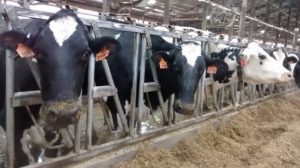
A cow moos in distress from a distant barn, as sprinklers shower water on those that crowd into one of the shelters that remains standing at Dakin Dairy Farm in Myakka City.
Owner Jerry Dakin says Hurricane Ian completely destroyed three of the farm’s open air shelters. The other five barns had parts of their roofs blown off.
“We’ve had over 250 animals that have died here,” Dakin says.
“In my lifetime, the most I’ve ever lost was maybe 10 baby calves or something. I have never lost this many animals. My brother’s down the road, he’s (lost) well over 300. We’ve never seen something so stressful on these animals. It’s just, it’s unbelievable.”

As of Sunday, Dakin had lost 12 percent of his herd of milking cows in the storm. He says many of the deaths were stress-related.
Workers piled up the dead cows to keep them away from the healthy ones. The state is sending an incinerator to help dispose of the carcasses, says Dakin.
In another pasture, some cows wade through water that floods the side of the road.

The farm lost power from Wednesday until late Saturday. Two generators powered machines to milk the cows, but the milk couldn’t be kept cold, and had to be thrown out.
In a business that was already hard, Dakin has a lot on his mind.
“I mean, we have some insurance but the challenging thing is with the inflation of all the materials, it’s gone up,” he says.
“I’m at a point, do I — What do I do here? Because this industry has just not been the greatest industry here.”

In the last decade there were hundreds of dairy farms in Florida but now there are just over 50, Dakin says.
Replacing a lost dairy cow could cost around $2,000 per animal, meaning Dakin Dairy is looking at half a million dollars in lost livestock from Hurricane Ian. More could die in the coming days.
Matt Lussier is a dairy farmer in Hawthorne, just east of Gainesville, and president of the board of Florida Dairy Farmers.
He says his farm did not lose any animals when it was hit by a hurricane in 2004, “but we lost 18 immediately afterwards. All the cows just were freaked out. And, it’s hard to describe how they would act, but the poor girls would just sit there, and be so overloaded with stress that they couldn’t recuperate.

“It’s very similar to seeing a dog who gets freaked out by a thunderstorm. Well, have that storm last 36 hours and pummel them,” says Lussier.
“As farmers it’s heartbreaking for us. They are not only our livelihood they are really part of the family.”
Cows are cold weather animals, and the high cost of keeping them cool in Florida, plus shipping in feed, are particular challenges for dairy farmers in the southeast, not to mention hurricanes, according to Lussier.
“We are dealing with a federal pricing system that is in drastic need of an overhaul to reflect properly what it costs to move milk out of the southeast,” he says.
Christa Court, assistant professor of regional economics at the University of Florida, is beginning to track the damage Hurricane Ian did to farms, from lost beehives to flooded vegetable fields to livestock.
“Hurricane Irma in 2017, we estimated over a billion dollars of damage just in agricultural losses,” says Court.

Every year, Dakin Dairy welcomes elementary school students on field trips to see the cows and the milk operation, so lots of local people know the place.
After Hurricane Ian passed, the family-owned farm posted about their losses on social media, and people started showing up to help.
“If they need help, like getting them herded a certain place or if they need injections,” says Marissa Souders, a 17-year-old member of Future Farmers of America (FFA), who came with several friends.
“We can help with that kind of basic veterinary stuff that we have experience in.”

“I’m going to feed the baby goats,” says a boy named Logan, as he dons blue plastic gloves and follows small group of moms and their children into the goat pen.
Courtney Dakin says the farm has seen an outpouring of support.
“We have people from Plant City from Winter Haven everywhere. It’s absolutely humbling to see all these people come out here and literally show up on our front doorstep, saying ‘How can we help you?’ It’s absolutely amazing,” she says.

As tractors drive in and out and volunteers move shards of metal that fell from the roofs, owner Jerry Dakin says he’s trying to focus on the basics, like getting the cows milked, in shelter, getting them water.
“Disasters like this are when people leave agriculture and we’ve got to keep food in America. We’ve got to do whatever we need to do to keep farmers here,” Dakin said.
The US Department of Agriculture provides some emergency aid for farmers after a natural disaster. Dakin says the support of the community will be crucial in the days and weeks ahead.
“The farmers of Florida, while we are dwindling in number, we’re here. We’re doing our job every day. Even the folks that got hit directly by the storm,” Lussier says.
“We battled through the storms and we will continue to feed the people of Florida. Don’t think we’re not doing our jobs because the store shelves are empty. That’s a temporary thing. We will have them full, right quick.”

























